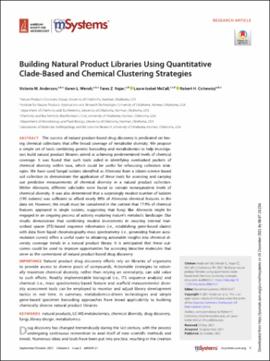| dc.contributor.author | Anderson, Victoria M. | |
| dc.contributor.author | Wendt, Karen L. | |
| dc.contributor.author | Najar, Fares Z. | |
| dc.contributor.author | McCall, Laura-Isobel | |
| dc.contributor.author | Cichewicz, Robert H. | |
| dc.date.accessioned | 2021-12-06T16:53:55Z | |
| dc.date.available | 2021-12-06T16:53:55Z | |
| dc.date.issued | 2021-10-26 | |
| dc.identifier.citation | Anderson VM, Wendt KL, Najar FZ, McCall, L-I, Cichewicz RH. Building Natural Product Libraries Using Quantitative Clade-Based and Chemical Clustering Strategies. mSystems. 2021; 16(5). https://doi.org/10.1128/mSystems.00644-21 | en_US |
| dc.identifier.uri | https://hdl.handle.net/11244/331325 | |
| dc.description.abstract | The success of natural product-based drug discovery is predicated on having chemical collections that offer broad coverage of metabolite diversity. We propose a simple set of tools combining genetic barcoding and metabolomics to help investigators build natural product libraries aimed at achieving predetermined levels of chemical coverage. It was found that such tools aided in identifying overlooked pockets of chemical diversity within taxa, which could be useful for refocusing collection strategies. We have used fungal isolates identified as Alternaria from a citizen-science-based soil collection to demonstrate the application of these tools for assessing and carrying out predictive measurements of chemical diversity in a natural product collection. Within Alternaria, different subclades were found to contain nonequivalent levels of chemical diversity. It was also determined that a surprisingly modest number of isolates (195 isolates) was sufficient to afford nearly 99% of Alternaria chemical features in the data set. However, this result must be considered in the context that 17.9% of chemical features appeared in single isolates, suggesting that fungi like Alternaria might be engaged in an ongoing process of actively exploring nature’s metabolic landscape. Our results demonstrate that combining modest investments in securing internal transcribed spacer (ITS)-based sequence information (i.e., establishing gene-based clades) with data from liquid chromatography-mass spectrometry (i.e., generating feature accumulation curves) offers a useful route to obtaining actionable insights into chemical diversity coverage trends in a natural product library. It is anticipated that these outcomes could be used to improve opportunities for accessing bioactive molecules that serve as the cornerstone of natural product-based drug discovery. | en_US |
| dc.description.sponsorship | Open Access fees paid for in whole or in part by the University of Oklahoma Libraries. | en_US |
| dc.language | en_US | en_US |
| dc.rights | Attribution 4.0 International | * |
| dc.rights.uri | https://creativecommons.org/licenses/by/4.0/ | * |
| dc.subject | Natural Products | en_US |
| dc.subject | LC-MS Metabolomics | en_US |
| dc.subject | Chemical Diversity | en_US |
| dc.subject | Drug Discovery | en_US |
| dc.subject | Fungi | en_US |
| dc.subject | Library Design | en_US |
| dc.subject | Metabolomics | en_US |
| dc.title | Building Natural Product Libraries Using Quantitative Clade-Based and Chemical Clustering Strategies | en_US |
| dc.type | Article | en_US |
| dc.description.peerreview | Yes | en_US |
| dc.identifier.doi | 10.1128/mSystems.00644-21 | en_US |
| ou.group | College of Arts and Sciences::Department of Chemistry and Biochemistry | en_US |

